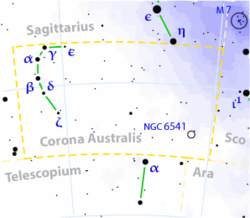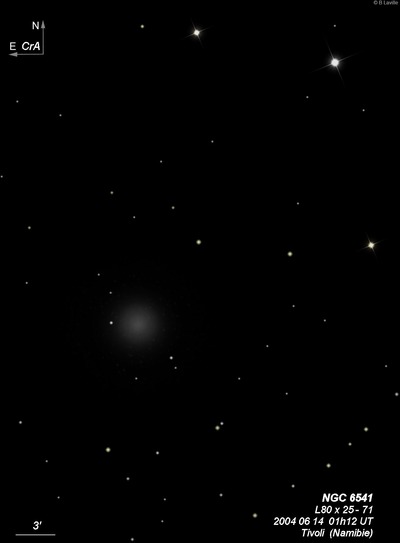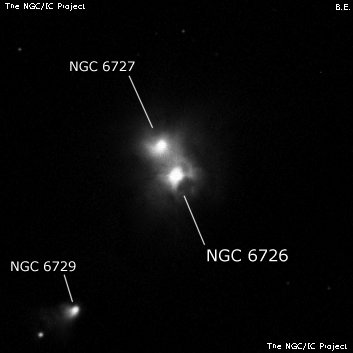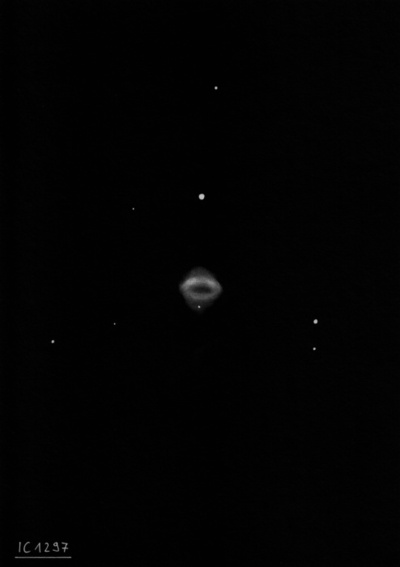The Southern Crown is the ninth smallest but quite prominent constellation of the southern sky under the feet of Sagittarius, east of Scorpio, in the Milky Way region of the richly interwoven interstellar medium. In our area it only partially rises above the horizon in the summer months, if we want to see it in its entirety, we must travel at least 5 degrees south, possibly as far as the Mediterranean region. There we can easily find it because of its shape, as it is otherwise quite a striking pattern. Although the brightness of none of its stars exceeds 4th magnitude, the short curve formed by the stars α, β, γ, δ and θ of the CRA very aptly resembles its corona. It lies on the southeastern boundary of the Milky Way and contains several nice objects, including two beautiful binaries, a large bright globular cluster, and an interesting complex of dark dust clouds and a bright reflection nebula.

ε CrA - An eclipsing variable star with a period of 14 hours. Since it is located on the northern edge of the constellation, it can be seen here as well, at least from areas at higher altitudes and without light pollution.
γ CrA - tight binary star, whose equally bright 5th magnitude components orbit each other every 120 years. We can distinguish them with a larger telescope. It is located at a distance of 58 light years.
κ CrA - A remarkable binary star in the rich Milky Way, whose both blue-white companions with magnitudes of 5.9 and 6.6 have a separation of 21.4 arcseconds. Therefore, they can be easily distinguished even in a small telescope.
Brisbane 14 - The double star observed only 12' WSW of the reflection nebula NGC 6726-27, as a nearly equally bright pair of blue-white components with magnitudes 6.6 and 6.8, which can be resolved even with a small telescope. The mutual separation of the components is 12.7".
RX J185635-3754 - Under this obscure designation hides our closest neutron star, which is located at a distance of 200 light-years. With its apparent magnitude of 26mag, it cannot be observed in any case, it was discovered only in 1996 by the Hubble Space Telescope. It is a remnant of a supernova explosion that occurred a million years ago.
NGC 6541

Niccolo Cacciatore, an assistant to Giuseppe Piazzi at Palermo, discovered NGC 6541 = D 473 = h 3726 on 19 Mar 1826, while searching for Comet C/1825 N1 (Pons) with a small refractor. James Dunlop independently discovered this globular a few months later on 3 Jul 1826 and described "a very bright round highly condensed nebula, about 3' diameter. I can resolve a considerable portion round the margin, but the compression is so great near the centre, that it would require a very high power, as well as light, to separate the stars; the stars are rather dusky." He notes 5 observations were made and his position is 6' northwest of the center. John Herschel's first observation was on 1 Jun 1834 (h3726) and he reported "globular, B, R, e comp, v Fine; diameter of most comp part = 11 seconds of time in RA; stars 15..16m. The scattered stars extend to three times the diameter and die away very gradually." He references D 473 in the Cape catalogue but wasn't aware of Cacciatore's earlier observation.
200/250mm - 8" (7/16/82): bright, fairly small, well concentrated to bright core. Mottled halo but no resolution. Located 20' SE of a mag 5 star (h 5014 = 5.8/5.8 at 1.8"). Very far south (low elevation) for viewing from Northern California.
400/500mm - 18" (7/9/02 - Magellan Observatory, Australia): this beautiful globular is set in a rich star field and is strongly compressed with a blazing core. At 171x, the halo is ~8' and highly resolved into a couple of hundred stars mag 12 and fainter. A few brighter stars (field?) are mixed in, including mag 11 stars on the east and southwest side of the halo. The stars are densely packed towards the core - another southern showpiece globular!
Notes by Steve Gottlieb
NGC 6726

Julius Schmidt discovered NGC 6726, along with NGC 6727, in October 1860 with the 6.2" refractor at the Athens Observatory. He made a second observation on 8 Feb 1861 (also NGC 6729) that was published in 1865 (AN 65, 263) and mentioned it was first seen in 1860. Albert Marth rediscovered this bright reflection nebula on 2 Jul 1864 and noted "* 7m in a F, pL, white envelope." As these bright reflection nebulae are only 30' SE of the showpiece globular NGC 6723, it's surprising they were missed by John Herschel.
200/250mm - 8" (7/31/81): two fairly bright, round patches in contact surrounding a wide pair (B 957) consisting of a mag 7.2 star and the variable TY CrA (8.8-12.5) at 58". A closer double star BRS 14 (6.5/7.0 at 13") to the SW. In a stunning low power field with NGC 6729 and globular cluster NGC 6723.
400/500mm - 17.5" (7/29/92): two bright, round nebulae oriented SSW-NNE: The SSW component (NGC 6726) surrounds a mag 7.2 star and the NNE component (NGC 6727) surrounds the variable star TY Coronae Australis (mag 9.5-10). Both nebulae are roughly 1.5' diameter and in contact with overlapping halos. The evenly matched double star BRS 14 = 6.6/6.8 at 13" is 13' SW. Very unusual dark field is void of stars and set in a striking low power field with nebula NGC 6729 and globular NGC 6723.
Notes by Steve Gottlieb
IC 1297

Williamina Fleming discovered IC 1297 in 1894 on a photograph of stellar spectra taken at Harvard College Observatory's Arequipa station in Peru. Pickering announced the discovery in AN 3227. Robert Innes independently found it on 30 Oct 1909 and reported it as "a planetary nebula looking like a double star out of focus, 9.3 mag." Diameter 8"x6", longer axis is in 270°-90°."
A star (HD 180206) is also plotted at this position on the Uranometria 2000 Atlas because the CoD and CPD catalogue included the central star (RU CrA) as an entry.
300/350mm - 13.1" (8/8/86): bright, small, 10"-15" diameter, slight bluish-green color. Very pretty sight at 166x and 214x, estimate V = 11.5-12.0.
Notes by Steve Gottlieb